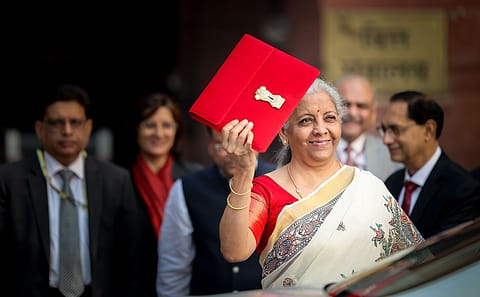An aam aadmi Budget with a topping of reform
The eighth Budget presented by Finance Minister Nirmala Sitharaman seeks to assuage the concerns of the middle class by unveiling major tax concessions aimed at boosting consumption.

Call it an aam aadmi (common man) Budget, and you wouldn't be terribly off the mark. True to style, Finance Minister Nirmala Sitharaman's eighth Budget was devoid of drama, but the aim and objective of the document was amply clear. It was also a relatively short speech--lasting all of an hour and 14 minutes--and focussed on the nuts and bolts of the message she wanted to get across this time. And what was the message? Clearly, two messages came through--that the Narendra Modi government was aware of the concerns being voiced by the middle class over the past several months, with this category getting squeezed with rising prices and depleting purchasing power.
Towards that end, Budget 2025 came across as one with the overriding objective of seeking to assuage the concerns of the middle class. In fact, one of the key tenets this time was to "enhance the spending power of India's rising middle class". Uplifting household sentiments was also another key objective spelt out by the Budget, as part of the aspiration for Viksit Bharat, or a Developed India. True, Budget 2025 did not fire up the stock markets; the BSE Sensex is up just 0.02% as I write this, and there was no real big bang for the market players to latch on to.
Middle class in focus
Instead, the big bonanza was aimed at firing up the middle class and seeking to put more money in their hands by a big tax relief--under the new tax regime, there will now be no tax on income up to ₹12 lakh, which works out to a relief of ₹12.75 lakh when the standard deduction of ₹75,000 is added. New slabs have also been introduced. Given the urban consumption distress which has become a recurring theme of late (leading FMCG CEOs have been voicing their concerns about the consumption squeeze in urban markets), the hope is that the tax relief would lead to more consumption and hence more investment.
The "fuel" in India's journey of development--the India@2047 Viksit Bharat journey--is "reform", according to the Budget. Towards that end, the Budget aims to unveil both financial sector reforms, and a move towards tax and regulatory reform with 'trust' being the guiding principle. A move from 'dand' (punishment) to 'nyay' (justice). Under financial sector reforms, the Grameen Credit Score framework, the NaBFID partial credit enhancement facility for corporate bonds for infrastructure, the revamped central KYC registry, the move towards a speedy approval of company mergers and the big one--the raising of the FDI limit for insurance to 100%--are important steps.
Tax breaks
The changes in the direct taxes and New Income Tax Bill are also aimed at deepening tax reforms with the focus on enhancing the trust factor with citizens. Importantly, a high-level committee is being set up for regulatory reforms, which will submit its report in a year. The aim is to have a "light touch regulatory framework" based on principles and trust which aims to unleash productivity and employment. These steps are aimed at addressing the concerns of many who have been voicing their concerns around excessive regulation and needless clampdowns which are seen to be stymying animal spirits and curbing entrepreneurial energies. In a pre-Budget round table, legal luminary Cyril Shroff did not mince his words when he said that India's financial sector was witnessing heavy-handed action by regulators. The FM's announcement of a light-touch, trust-based regime would, then, be welcome news. Rationalisation of TDS and TCS are other reliefs. Tax deduction limit for senior citizens has been upped from ₹50,000 to ₹1 lakh, while the annual limit of ₹2.4 lakh for TDS on rent has been increased to ₹6 lakh.
Recommended Stories
Ease of Doing Business as a theme has been underscored by the Narendra Modi government for long, and this Budget takes it a step further by announcing the setting up of an Investment Friendliness Index for states, in the spirit of competitive federalism. With states vying to woo investments these days, this would be a good barometer for potential investors and ensure states gear up with reforms at their end making it easier to attract investments.
MSMEs is another theme which gets attention in this Budget, with 5 lakh first-time entrepreneurs, including women, scheduled castes and tribes getting a new scheme which will provide term loans up to ₹2 crore during the next five years. Startups also get a further boost with the Budget announcing a ₹10,000 crore fund of funds for startups.
While these focus areas were clear, the Budget came across as a continuation of the Viksit Bharat theme. That, in a sense, is understandable since the Modi government has always been about continuity and carrying forward the steps from one Budget to another. Whether the tax reliefs translate into a consumption revival will be keenly watched. And, like it is said of Budgets in general, if the Budget did not contain any major negative surprises, it is a good one!